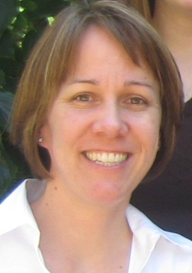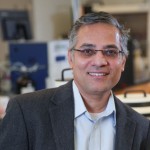
Sophia Hayes, 2015 Saint Louis Award winner
Sophia Hayes is Professor of Chemistry at Washington University in St Louis. Her BS is from UC Berkeley in Chemistry. She spent three years in energy and environmental management consulting at RCG/Hagler, Bailly, Inc in San Francisco, CA, before she earned a PhD in Chemistry from UC–Santa Barbara (1999), on a five-year fellowship from Sandia National Lab. At Santa Barbara she worked with Hellmut Eckert on solid-state NMR of lithium anode materials and amorphous carbon.
Dr Hayes was Directorate Postdoctoral Fellow at Lawrence Livermore National Laboratory (Materials Science) with Dr Glenn Fox working in collaboration at UC Berkeley (Chemical Engineering) with Professor Jeff Reimer, constructing an optically-pumped NMR apparatus and studying semiconductors and nanomaterials. She subsequently was named an Alexander von Humboldt Postdoctoral Fellow in Physics at University of Dortmund, Germany, performing optically detected NMR on semiconductors, in collaboration with Prof Dieter Suter.
Since 2001, Dr Hayes has been at Washington University, starting as an Assistant Professor and rising to full Professor in 2015. Her research efforts have been recognized with an NSF CAREER Award (2003), an Alfred P Sloan Foundation Fellowship (2007), and the Regitze R Vold Memorial Prize in solid-state NMR (2009).
Dr. Hayes’ research is focused on problems related to materials science where NMR spectroscopy can play a significant role. She and her group build specialized probes (i.e., with light access, high pressure gases, supercritical fluids). Her group is currently focused on three research areas.
- in situ elevated-pressure and -temperature 13C-NMR of CO2 for materials discovery in mineralization (forming carbonates) and carbon capture (separating CO2 from flue gases). In this innovative project, in situ high-pressure NMR is employed under conditions that mimic geosequestration environments. This work, as part of a DOE NETL project, is focused on elevated-pressure and elevated-temperature NMR to monitor in situ reactions of CO2 gas with minerals and rocks envisioned for its capture and conversion to stable solid carbonates such as MgCO3 and CaCO3. Project collaborators include Dan Giammar (Chemical Engineering), Mark Conradi (Physics), and Phil Skemer (Earth and Planetary Sciences). In situ 13C-NMR is coupled with a reaction vessel at high pressure to monitor CO2(g) and HCO3–(aq), quantify conversion to CO32– as a solid carbonate, characterize metastable carbonates, and assess pH. In an extension of this work, the Hayes group is assessing flue gas “carbon capture” materials in collaboration with a DOE EFRC team with Chris Jones and Krista Walton, both in Chemical Engineering at Georgia Tech, where NMR can characterize CO2 binding sites, degradative effects of the acidic gases on these materials, and measure temperature-dependent adsorption/desorption reactions.
- Optically-pumped NMR (OPNMR) of semiconductors and semiconductor heterostructures. Dr Hayes has pioneered research that touches closely on condensed matter physics, the “orienting/ordering” of electrons and nuclear spins through optical pumping. She was the first to combine optically-pumped NMR and optically-detected NMR — two measurement modalities to assess electrons that are polarized in a semiconductor — through laser irradiation with NMR (and optical) detection inside the NMR magnet at cryogenic temperatures. In this research, she has made discoveries in GaAs and recently in CdTe semiconductors, including connecting measurements to the magnetic-field distorted electronic band structure, termed “Landau levels”. Her work has shown the light-hole transitions very clearly, phenomena not found using other measurement schemes. Her ongoing research has focused on examining the effects of electron localization in semiconductors, a process that affects solar cell performance and other opto-electronic processes.
- Quadrupolar solid-state NMR and modeling of molecular clusters and thin films for “next-generation” semiconductor devices. In a new research focus, Dr Hayes has undertaken studies of clusters of hydroxo-bridged metals (Ga, In, Al) that are precursors to thin films, similar to indium gallium oxide or “IGO” used in thin film transistor semiconductor devices. She and her group collaborate with Doug Keszler at Oregon State University and Darren Johnson at the University of Oregon as part of an NSF Center for Chemical Innovation. This work represents some of the earliest studies performed on thin inorganic films (~200-400 nm) of metal oxides, and the Hayes group has discovered and is analyzing unusual NMR lineshapes for 69Ga and 71Ga quadrupolar species. Recent work has extended the thin film analyses to employ an emerging technique, dynamic nuclear polarization (DNP), for surface-sensitive NMR of 27Al in thin films. One of two DNP instruments in the US is in Professpr Marek Pruski’s lab at Ames, and the Hayes group is actively pursuing these new measurements to determine the structure of surfaces of thin films, information critical for their application in devices.
Dr Hayes is married to Dr Christopher Hagedorn, a chemical engineer, business executive, and Washington University alumnus. They are the proud parents of a daughter, Marina, who has grown up attending NMR conferences, amongst a diverse community of scientists and engineers, who visit and stay with the family for research trips, to play team bocce, and Cranium matches.


